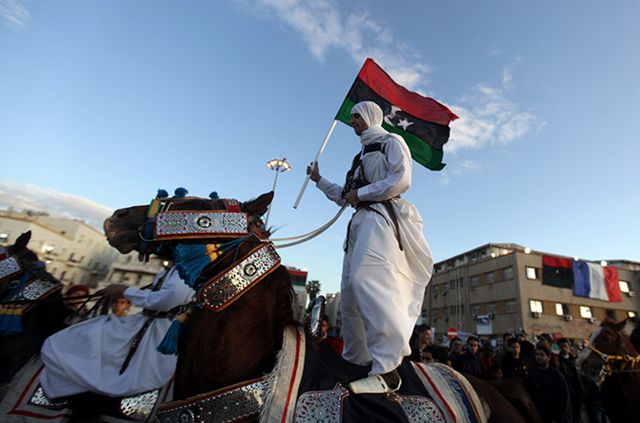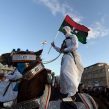
Mapping Qaddafi’s Tribal Allegiances in Libya: An Overview
Publication: Terrorism Monitor Volume: 9 Issue: 17
By:

After announcing that Libyan troops had suspended operations in Misurata, an official of the Libyan government suggested that armed tribesmen loyal to the regime would soon take their place. It would then be up to the tribesmen to negotiate with the besieged rebels or to carry on the fight: “If [the army] cannot solve the problem in Misurata, then the people from Zleitan, Tarhouna, Ben Walid, Tawargha and other villages will move in and talk to the rebels. If they don’t surrender, then they will engage them in fighting” (Tripoli Post, April 23; al-Jazeera, April 24). Khalid Kaim, Libya’s deputy foreign minister, said the loyalist tribes had several points of contention with the rebels, including the disruption of roads and trade and control of the Misurata seaport. On an ominous note, Kaim claimed that the army had tried to keep civilian casualties to a minimum, but the government could provide no guarantees that tribesmen would show the same restraint (BBC, April 23).
A One Man Regime
Colonel Mu’ammar Qaddafi’s regime looks weak from the outside. It is a one-man show. Qaddafi is the man who makes the important decisions in Libya. Not a single significant order can be issued without his approval. Qaddafi claims that he is neither a president nor a prime minister; he is only the leader of the revolution, in addition to being Africa’s self-appointed “King of Kings.” In theory, toppling a one-man regime with many enemies inside and outside the country should not be a difficult thing to do. In practice, however, it is a different matter, as Qaddafi has proved during his long rule of Libya.
The 1969 military coup that ultimately led to Qaddafi taking power was certainly not a one-man show. The officers behind the coup that toppled the regime of King Idriss al-Sanusi came from all over the country and were mainly influenced by the Nasserite pan-Arab popular movement at that time. Gradually, Colonel Qaddafi started to change and wanted to concentrate power onto himself, something which must have upset many of the people who were part of the coup or supported the new military regime. These people then started to defect, with some even plotting to remove Qaddafi from power.
In the 1980s and 1990s, Qaddafi’s regime defeated three major plots carried out by the National Front for the Salvation of Libya (NFSL). In 1984, NFSL members attacked the Colonel’s residence in Tripoli’s Bab al-Aziziya military compound. In the late 1980s, the National Front moved its camps and fighters to Algeria, where it hoped to launch a coup against Qaddafi. The third and final plot by the NFSL was carried out in 1993 by officers who came mainly from a powerful tribe that has otherwise been loyal to Qaddafi’s regime, the Warfalla. In the mid-1990s, Qaddafi also defeated an armed insurgency by the Libyan Islamic Fighting Group (LIFG), a jihadist movement made up mainly of veterans of Afghanistan’s anti-Soviet jihad (see Terrorism Monitor, May 5, 2005; November 3, 2005).
These coup attempts and insurgencies led Qaddafi to change the way he organized his armed forces. He started to see the army as a threat; the army could one day produce an officer who may try his own luck at a coup attempt as did the young colonel himself in 1969. To prevent such a scenario, Qaddafi created what can be described as a parallel army that was better equipped than the regular army. This parallel army is known in Libya today as the “Qaddafi Brigades,” the most famous of which is led by Khamis, a son of Colonel Qaddafi (for Khamis, see Militant Leadership Monitor, February 28). The parallel army’s main mission is to protect the regime from any revolt or coup attempt. It is not designed for fighting another army, and its members, who are known to be loyal to Qaddafi, are equipped with the best arms available to the Libyan armed forces.
Qaddafi’s Tribal Support
In addition to these loyal brigades, the survival of Qaddafi’s regime is dependent on a complex map of tribal allegiances and pacts with tribes, especially those in the western Libya. Some people say that the tribal influence in Libya is not that important today, pointing to the fact that the current uprising seem to be a popular movement that has support from different regions and tribes all over the country. They also believe that the tribes which are still supporting Qaddafi in the west of Libya are doing so out of fear of his regime. Both may be true, but the tribes in western Libya still hold the key to Qaddafi’s fate:
• The first tribe on which Qaddafi depends is his own, the Qadadfa. This tribe’s main base is in Sirte, in central Libya, on the Mediterranean coast. It is not a big tribe, but it is very powerful. Its members hold sensitive positions within the state and the armed units which are currently leading the fight. There are reports that each fighting unit includes a Qadadfa tribesman or two to insure its loyalty.
• The second important tribe on which the regime depends is the Megharha. Its base is in the south of Libya, around the city of Sabha, and a great number of the fighters in Qaddafi’s units come from this area. Their loyalty to the regime should not be questioned. Their position is very strong in the Libyan state, and their alliance to Qaddafi is cemented by family ties – Abdullah al-Sanusi, the head of military intelligence and the brother-in-law of Colonel Qaddafi, is a Meghrahi. Abd al-Basit al-Meghrahi, the Lockerbie bomber, is also a Meghrahi, as is obvious from his name. About two years ago, Colonel Qaddafi put great pressure on the British government to secure the release of Abd al-Basit from a Scottish prison. He wanted to please the Megharha tribe which was very angry at the prospect that Meghrahi, who was reported to be terminally ill, might die in jail in a foreign country. Some would also argue that Qaddafi wanted Meghrahi back home to ensure that he did not reveal any secrets about the Lockerbie bombing before dying.
• The third important tribe for the regime is the Warfalla. It is considered the largest tribe in Libya (more than one million strong, out of more than 6 million Libyans) and its members live all over the country, including Benghazi. Its main base is just to the south of Tripoli in an area called Bani Walid. The tribe’s members hold very important positions within the government and security agencies. The Warfalla’s relationship with Qaddafi suffered a setback after the 1993 failed coup, in which some Warfalla officers were implicated. Qaddafi saw the officers’ attempt against him as a betrayal, not only to him, but also to their own tribe, which Qaddafi had trusted and allowed to control a large part of the military and security institutions. In 1997, members of the Warfalla tribe executed the implicated officers. Some would argue that they were forced to do so by Qaddafi. Whether or not this is true, the fact is that Qaddafi managed to keep the blood of these dead officers on the hands of their tribe. In some Arab cultures, there is still an ancient tradition of tribal revenge – if a member of one tribe is killed by another tribe, then the victim’s tribe has the right to take revenge by killing a member of the other tribe. Sometimes these tit-for-tat killings can go on for decades. By making the Warfalla tribe kill its own officers, Qaddafi was able to make it an internal tribal issue. The matter was resolved when the leaders of the tribe renewed their pact with Qaddafi and his tribe. To this day, the Warfalla still compose an important part of the units that defend the regime (Reuters, March 8, 2011).
• The fourth tribe is the Tarhouna. They are also seen as loyal to Qaddafi and his tribe, and they occupy important positions within the security agencies. Their role became more important after the 1993 coup by the Warfalla officers, which led Qaddafi to give more prominent roles to other tribes. The Tarhouna’s importance also stems from the fact that they control vast areas south of Tripoli housing many army barracks and military compounds. In addition, much of Tripoli’s population is derived from the Tarhouna. This factor will become very important if the opposition tries to mount any kind of operation against the regime inside the Libyan capital.
Conclusion
These are only the most prominent of the tribes still seen as loyal to the Libyan regime, or at least not siding with the rebels against it. The reason these tribes stay loyal to the regime may be related to their desire to honor their historic pacts with the Qadadfa, the Colonel’s tribe. They could also be fearful of losing the power they hold if Qaddafi falls. Under his regime, members of these tribes have occupied important positions in the government. Now a new regime is emerging, based in the east of the country, where the majority of the rebels are from. It seems normal, therefore, that some tribes in the west of Libya would feel threatened by the emergence of a new rival power in the east that might try to separate them from the power they have enjoyed for so long. It will now be seen in the coming days whether these tribes are willing to enter the conflict as a third armed force.





